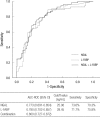The role of urinary liver-type fatty acid-binding protein in critically ill patients
- PMID: 23341719
- PMCID: PMC3546087
- DOI: 10.3346/jkms.2013.28.1.100
The role of urinary liver-type fatty acid-binding protein in critically ill patients
Abstract
Although several urinary biomarkers have been validated as early diagnostic markers of acute kidney injury (AKI), their usefulness as outcome predictors is not well established. This study aimed to determine the diagnostic and prognostic abilities of urinary liver-type fatty acid-binding protein (L-FABP) in heterogeneous critically ill patients. We prospectively collected data on patients admitted to medical and surgical intensive care units (ICUs) from July 2010 to June 2011. Urine neutrophil gelatinase-associated lipocalin (NGAL) and L-FABP at the time of ICU admission were quantitated. Of the 145 patients, 54 (37.2%) had AKI defined by the Acute Kidney Injury Network (AKIN) criteria. AKI patients showed significantly higher level of urinary NGAL and L-FABP and also higher mortality than non-AKI patients. The diagnostic performances, assessed by the area under the ROC curve, were 0.773 for NGAL and 0.780 for L-FABP, demonstrating their usefulness in diagnosing AKI. In multivariate Cox analysis, urinary L-FABP was an independent predictor for 90-day mortality. Urinary L-FABP seems to be promising both for the diagnosis of AKI and for the prediction of prognosis in heterogeneous ICU patients. It needs to be further validated for clinical utility.
Keywords: Acute Kidney Injury; Liver-Type Fatty Acid-Binding Protein; Neutrophil Gelatinase-Associated Lipocalin; Prognosis.
Figures



Similar articles
-
Neutrophil gelatinase-associated lipocalin and liver-type fatty acid-binding protein as biomarkers for acute kidney injury after organ transplantation.J Anesth. 2015 Apr;29(2):249-55. doi: 10.1007/s00540-014-1909-4. Epub 2014 Sep 10. J Anesth. 2015. PMID: 25205293
-
Urinary L-FABP and its combination with urinary NGAL in early diagnosis of acute kidney injury after cardiac surgery in adult patients.Biomarkers. 2013 Feb;18(1):95-101. doi: 10.3109/1354750X.2012.740687. Epub 2012 Nov 21. Biomarkers. 2013. PMID: 23167703
-
Urinary neutrophil gelatinase-associated lipocalin and L-type fatty acid binding protein as diagnostic markers of early acute kidney injury after liver transplantation.Biomarkers. 2012 Jun;17(4):336-42. doi: 10.3109/1354750X.2012.672458. Epub 2012 Mar 29. Biomarkers. 2012. PMID: 22455661
-
Neutrophil gelatinase-associated lipocalin (NGAL) as a biomarker for early acute kidney injury.Crit Care Clin. 2011 Apr;27(2):379-89. doi: 10.1016/j.ccc.2010.12.003. Crit Care Clin. 2011. PMID: 21440207 Review.
-
An overview of circulating and urinary biomarkers capable of predicting the transition of acute kidney injury to chronic kidney disease.Expert Rev Mol Diagn. 2024 Jul;24(7):627-647. doi: 10.1080/14737159.2024.2379355. Epub 2024 Jul 15. Expert Rev Mol Diagn. 2024. PMID: 39007888 Review.
Cited by
-
The Japanese Clinical Practice Guideline for acute kidney injury 2016.J Intensive Care. 2018 Aug 13;6:48. doi: 10.1186/s40560-018-0308-6. eCollection 2018. J Intensive Care. 2018. PMID: 30123509 Free PMC article.
-
Current Metabolic Status Affects Urinary Liver-Type Fatty-Acid Binding Protein in Normoalbuminuric Patients With Type 2 Diabetes.J Clin Med Res. 2017 Apr;9(4):366-373. doi: 10.14740/jocmr2934w. Epub 2017 Feb 21. J Clin Med Res. 2017. PMID: 28270898 Free PMC article.
-
Detection of early renal injury in children with solid tumors undergoing chemotherapy by urinary neutrophil gelatinase-associated lipocalin.Mol Clin Oncol. 2015 Nov;3(6):1341-1346. doi: 10.3892/mco.2015.631. Epub 2015 Aug 31. Mol Clin Oncol. 2015. PMID: 26807245 Free PMC article.
-
Biomarkers for assessing acute kidney injury for people who are being considered for admission to critical care: a systematic review and cost-effectiveness analysis.Health Technol Assess. 2022 Jan;26(7):1-286. doi: 10.3310/UGEZ4120. Health Technol Assess. 2022. PMID: 35115079 Free PMC article.
-
Methodological issues in current practice may lead to bias in the development of biomarker combinations for predicting acute kidney injury.Kidney Int. 2016 Feb;89(2):429-38. doi: 10.1038/ki.2015.283. Kidney Int. 2016. PMID: 26398494 Free PMC article.
References
-
- Hoste EA, Kellum JA. Acute kidney injury: epidemiology and diagnostic criteria. Curr Opin Crit Care. 2006;12:531–537. - PubMed
-
- Coca SG, Yalavarthy R, Concato J, Parikh CR. Biomarkers for the diagnosis and risk stratification of acute kidney injury: a systematic review. Kidney Int. 2008;73:1008–1016. - PubMed
-
- Kamijo A, Sugaya T, Hikawa A, Yamanouchi M, Hirata Y, Ishimitsu T, Numabe A, Takagi M, Hayakawa H, Tabei F, et al. Urinary liver-type fatty acid binding protein as a useful biomarker in chronic kidney disease. Mol Cell Biochem. 2006;284:175–182. - PubMed
-
- Matsui K, Kamijo-Ikemori A, Hara M, Sugaya T, Kodama T, Fujitani S, Taira Y, Yasuda T, Kimura K. Clinical significance of tubular and podocyte biomarkers in acute kidney injury. Clin Exp Nephrol. 2011;15:220–225. - PubMed
MeSH terms
Substances
LinkOut - more resources
Full Text Sources
Other Literature Sources
Miscellaneous

